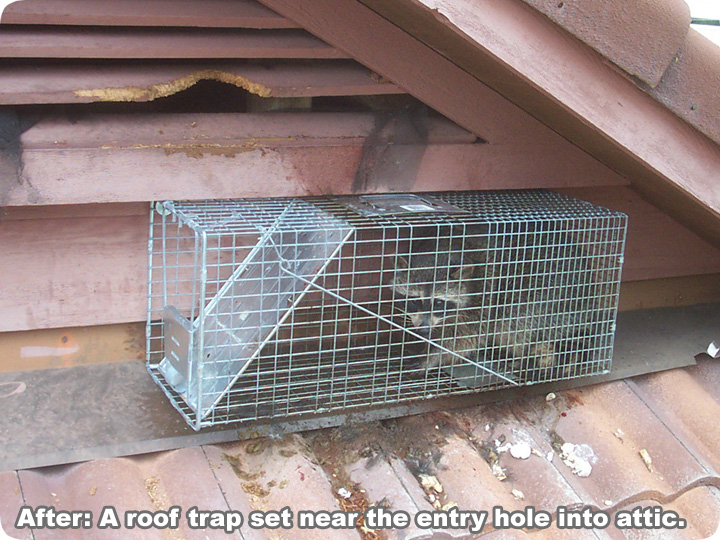
Click the buttons to the left or right for more examples of how the pros set traps in different situations.
In the above photo, you can see that a raccoon has chewed and scratched open a part of a gable vent. The hole might not look big, but it's plenty large enough for a raccoon of this size. I set a trap in a secure spot right below the opening, bolted it into teh wall to keep
it stable, and voila!
If you need professional help, click my Hire A Pro page. I've compiled the USA's best directory of raccoon removal experts.
Raccoon in homes - You’re probably wondering why a raccoon would chose to live inside of a home when there is a forest full of tall, quiet trees to sleep in. In fact, if you’re a parent, you’re probably wondering why you’re not outside, sleeping in a quiet tree. Raccoons are indifferent to the noises humans make as long as we don’t spend any time in the areas they like to invade within a home. A prime example of this is the attic. A raccoon will enter an attic and make it a den without hesitation. Most raccoons sneaking into a house are females looking for a good place to have their babies. Male raccoons will kill the litters of kits not their own. This sends the female back into a heat cycle, allowing that murdering male to pass on his genetics rather than those of his rival. It is survival of the fittest at its best. Of course, this means a mother raccoon wants to be as far away from males as she can be while she raises her kids. Where better to go than inside of a human house? The best thing you can do to prevent this scenario is to keep an eye on the exterior of your home. Any areas that are damaged or have holes in them need to be immediately remedied.
Click below photos for more examples of trap sets by professionals:
This is a series of photos of trap sets in the field. These examples are meant to show how professional trap setting looks. The reality is that every case of raccoon trapping is different: number of raccoons, location, type of architecture of the roof or attic they are in, etc. I've done over 1000 raccoon trapping jobs, and every set has been different. There are so many little variables that mean the difference between success and big problems! Trapping is not for amateurs.
If you need professional help, click my Hire A Pro page. I've compiled the USA's best directory of raccoon removal experts.
Raccoon in homes - You’re probably wondering why a raccoon would chose to live inside of a home when there is a forest full of tall, quiet trees to sleep in. In fact, if you’re a parent, you’re probably wondering why you’re not outside, sleeping in a quiet tree. Raccoons are indifferent to the noises humans make as long as we don’t spend any time in the areas they like to invade within a home. A prime example of this is the attic. A raccoon will enter an attic and make it a den without hesitation. Most raccoons sneaking into a house are females looking for a good place to have their babies. Male raccoons will kill the litters of kits not their own. This sends the female back into a heat cycle, allowing that murdering male to pass on his genetics rather than those of his rival. It is survival of the fittest at its best. Of course, this means a mother raccoon wants to be as far away from males as she can be while she raises her kids. Where better to go than inside of a human house? The best thing you can do to prevent this scenario is to keep an eye on the exterior of your home. Any areas that are damaged or have holes in them need to be immediately remedied.
Click below photos for more examples of trap sets by professionals:
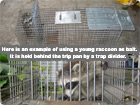 |
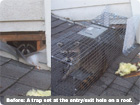 |
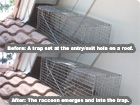 |
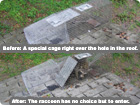 |
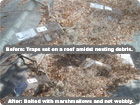 |
This is a series of photos of trap sets in the field. These examples are meant to show how professional trap setting looks. The reality is that every case of raccoon trapping is different: number of raccoons, location, type of architecture of the roof or attic they are in, etc. I've done over 1000 raccoon trapping jobs, and every set has been different. There are so many little variables that mean the difference between success and big problems! Trapping is not for amateurs.

